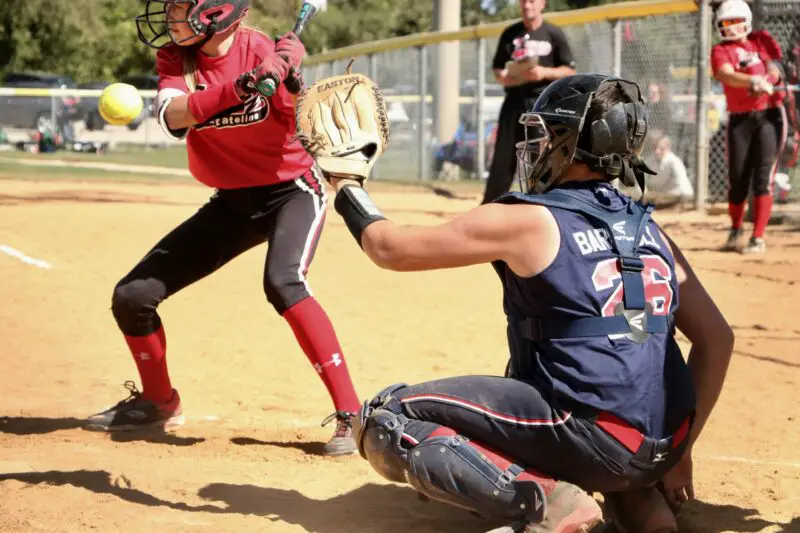
A baserunner who takes a big lead on the pitch, or who is not alert when returning to the base after the pitch is a candidate for the softball pickoff play. The catcher, who has a full view of the field an can see all aspects of a play as it develops, is in an ideal position to call for a pickoff of lead or back runners at first, second or third base. A good strategy is to be aware of the runners tendencies. Does she always take a big lead? Is the team aggressive on the basepaths? By being aware of the amount of lead that a runner takes, you can set up her up for a timed pickoff for a sure out.
The Softball Pickoff
Once a pick-off play has been called, the catcher’s responsibility is to receive the pitch and to throw the ball to the appropriate base. Care must be taken to concentrate first on the catch, and then on the throw. The excitement of the play can create an error if the catcher is playing the ball before receiving it. The throw itself must be quick, accurate, and unexpected by the runner. If these criteria cannot be met, for whatever reason, the ball should be held. An indiscriminate throw, with little chance of getting the out, only enhances the possibility that the base runner will advance, possibly for more than one base if there is an overthrow.
If a pick-off opportunity arises, and there is adequate defensive coverage, the catcher may make a play on a runner even though it has not been pre arranged. If there is no one in position to receive the throw, a fake throw may be used to force the runner back to her base, or farther off base. If a runner is more than ten feet from the nearest base, the catcher should be alert for a delayed steal. The best way to deal with this situation is to force the runner to commit herself by running directly toward her. No throw should be made until the runner is definitely committed in a given direction If she fails to commit, and she is close enough to home plate, the catcher should be able to tag her for the putout or trap the runner in a rundown. The minimum is that the runner should be forced back to the base she came from if you can not get the out.
Who covers the bases
If here is a pickoff at third base, there are 2 possible receivers. It could be a quick snap to the third base player who is just near the basepath a step from the base or it could be the shortstop who curls in behind third base to take the throw. Each one has its purpose and communication is critical in both instances. There is also a potential pick off play at second base when the runner on 2 takes a big lead and is not quick about getting back to the base when the catcher is throwing the ball back to the pitcher. A quick turn and snap to second can get that runner out easily. A pick off at first base is generally taken by the first base player. Often they will get between the runner and the base to prevent the runner from touching the base if they have the ball.
Be aware though that on pickoff plays, the option for the aggressive base runner is to take off for the next base as soon as the ball is thrown in their direction. This means that you need to be very aware and have coverage a base ahead of every runner. For every defensive play you run, you need to be aware of the offensive counter plays.
The other key to success in a pick off play is backup and coverage. This is why everyone needs to know it’s happening. The signal must be read by all infielders and outfielders because they need to assume their positions to ensure success and to prevent the runner from advancing any extra bases. Pick off plays also require a lot of practice. Be sure to have all players who play each position practice it so everyone is good at the play in case you need to make substitutions. Good plays are not only for the starters. Everyone should know how to run them.

